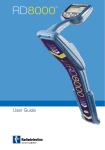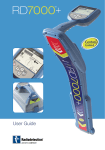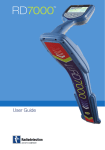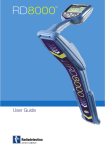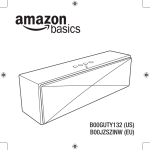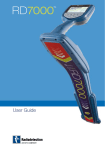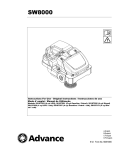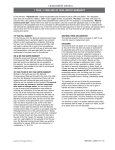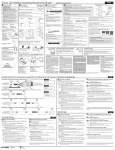Download User Guide
Transcript
™ User Guide ENGLISH FRANÇAIS 1 22 Preface About this guide This guide provides basic operating instructions for the RD7000 receiver and transmitter. Please read this guide in its entirety before attempting to operate the RD7000. This guide is intended as a portable reference only. For detailed instructions, please refer to the RD7000 operation manual, which is available for download from www.radiodetection.com. To download the manual go to the Library section, which is accessible via the menu; next go to Cable and Pipe Locators and then select User Manuals and click the RD7000 Operation Manual link. The online User Manual library also contains links to the Centros™ Manager manual. Copyright statement Copyright 2008 Radiodetection Ltd - SPX Corporation. All rights reserved. Radiodetection is a subsidiary of SPX Corporation. SPX and Radiodetection are trademarks of Radiodetection Ltd. and SPX Corporation. Due to a policy of continued development, we reserve the right to alter or amend any published specification without notice. Copyright 2008 Radiodetection Ltd - SPX Corporation. This document is protected by copyright and may not be copied, reproduced, transmitted, modified or used, in whole or in part, without the prior written consent of Radiodetection Ltd. Trademarks RD7000, RD8000, RD4000, flexitrax, SurverCERT, StrikeAlert, SideStep and eCAL are trademarks of Radiodetection Ltd. Important notices When reporting any problems to your Radiodetection Dealer or Supplier it is important to quote the unit serial number and the purchase date. WARNING! This equipment is NOT approved for use in areas where hazardous gases may be present. WARNING! When using the transmitter, switch off the unit and disconnect cables before removing the battery pack. Reduce audio level before using the earpiece. Batteries should be disposed of in accordance with your company’s work practice, and/ or any relevant laws or guidelines in your country. This instrument, or family of instruments, will not be permanently damaged by reasonable electrostatic discharge and has been tested in accordance with IEC 801-2. However, in extreme cases temporary malfunction may occur. If this happens, switch off, wait and switch on again. If the instrument still malfunctions, disconnect the batteries for FCC and Industry Canada statements This device complies with part 15 of the FCC Rules. Operation is subject to the following conditions: (1) This device may not cause harmful interference, and (2) this device must accept any interference received, including interference that may cause undesired operation. Changes or modifications not expressly approved by the party responsible for compliance could void the user’s authority to operate the equipment. To comply with the FCC RD explore compliance requirements, this device and its antenna must not be colocated or operated in conjunction with any other antenna or transmitter. Training Radiodetection provides training services for most Radiodetection products. Our qualified instructors will train equipment operators or other personnel at your preferred location or at Radiodetection headquarters. For more information go to www.radiodetection.com or contact your local Radiodetection representative. ENGLISH DEUTSCH WARNING! The RD7000 will detect almost all buried conductors but there are some objects that do not radiate any detectable signal. The RD7000, or any other electromagnetic locator, cannot detect these objects so proceed with caution. There are also some live cables which the RD7000 will not be able to detect in Power mode. The RD7000 does not indicate whether a signal is from a single cable or from several in close proximity. Español five seconds and then reinstall and switch the unit on. The receiver and transmitter are designed so that they do not require regular calibration. However, as with all safety equipment, it is recommended that they are serviced at least once a year either at Radiodetection or an approved repair center. FRANÇAIS Service and Maintenance NEDERLANDS Italiano Radiodetection products, including this user guide, are under continuous development and are subject to change without notice. Go to www.radiodetection.com or contact your local Radiodetection representative for the latest information regarding the RD7000 or any Radiodetection product. RD7000 receiver 2 1 3 4 5 8 6 7 8 15 14 10 11 9 12 13 14 16 17 23 24 18 19 20 21 22 Keypad. 2. LCD. 3. Battery compartment. . Accessory slot. . Headphone jack. 20. Operating mode indicator. 21. Null / Peak / Single Mode icon: Indicates antenna selection. 22. Sonde icon: Indicates that the signal source is from a sonde. Receiver keypad Power key: Switches the unit on and off. Opens the receiver menu. 7. ƒ key: Selects frequency. Closes submenu. 8. Up and down arrows: Adjusts the signal gain. Scrolls through the menu options. . Antenna key: Toggles peak and null (PL and TL only) modes. Open submenu. Prolonged keypress toggles between depth or current display on the LCD. 2. Current / depth indicator. Español . 23. Line icon: Indicates that the signal source is from a line. DEUTSCH 1. 19. A-Frame icon: Indicates when the A-Frame is connected. ENGLISH Receiver features Receiver screen icons FRANÇAIS 10. Indicates the signal strength and peak marker. 11. Signal strength: Numeric indication of signal strength. 12. Peak arrows: Indicates the location of the line relative to the receiver. 13. Battery icon: Indicates the battery level. Italiano 14. Volume icon: Displays the volume level. 15. Fault-Find arrows (PL and TL only) 16. Radio Mode: Indicates when Radio Mode is active. NEDERLANDS 17. Power Mode: Indicates when Power Mode is active. 18. Accessory indicator: Indicates when an accessory is connected. Tx1, Tx3 and Tx10 transmitters 1 2 3 4 6 5 7 10 11 6 12 17 18 8 19 13 14 15 16 9 20 Keypad. 2. LCD. 3. Removable accessory tray. 17. Voltage warning indicator: Indicates that the transmitter is outputting potentially hazardous voltage levels. Transmitter keypad Power key: Switches the unit on and off. Opens the transmitter menu. . ƒ key: Selects frequency. Menu navigation key. . Up and down arrows: Adjusts the output signal. Scrolls through the menu options. 7. Measure key: Toggles measurement display between volts, current and impedance. Note: displayed measurements are based on the currently selected mode or the attached accessory, if applicable. Opens a submenu. 18. Volume icon: Displays the volume level. 19. Pairing icon (Tx3B and Tx10B only). For use with RD8000 receivers only. 20. Bluetooth® icon (Tx3B and Tx10B only). For use with RD8000 receivers only. Español . ENGLISH 1. 16. CD Mode indicator: Indicates that the transmitter is in Current Direction Mode. DEUTSCH Transmitter features 8. Battery icon: Indicates the battery level. . Alphanumeric description of selected operation mode. FRANÇAIS Transmitter screen icons 10. Standby icon: Appears when the transmitter is in Standby Mode. 11. Output level: Displays transmitter output power. Italiano 12. Clamp icon: Indicates when a clamp is connected. 13. DC icon: Appears when the transmitter is powered from a DC source. NEDERLANDS 14. Induction indicator: Appears when the transmitter is in Induction Mode. 15. A-Frame: Indicates when the transmitter is in Fault-Find Mode. Before you begin IMPORTANT! Please read this section before you attempt to operate the RD7000! Starting the system The receiver and transmitter are battery powered. Install good quality D-cell NiMH or Alkaline batteries into the receiver and transmitter battery compartments. Alternatively, you can power the transmitter from a mains or vehicle power source using a Radiodetection supplied adapter. To switch the receiver or the transmitter on, press and hold the keypad Power Key for two seconds. NOTE: Once the system is switched on, pressing the Power Key momentarily will activate the receiver or transmitter menu. Shutting down To switch the receiver or the transmitter off, press and hold the key for two seconds. System setup It is important that you set up the system according to your personal preferences and operating requirements before you conduct your first survey. You can set the system up using the RD7000 menu as described below. Before changing settings, ensure the receiver or transmitter is switched on by pressing the keypad Power Key for two seconds. Power / mains frequency Select the correct frequency (50 or 60Hz) for your country or region’s national power supply. To change power frequency on the transmitter and the receiver: 1. Press the the menu. key momentarily to enter 2. Scroll to the POWER option using the arrow keys. 3. Press the . Scroll up or down using the . Press the key to accept your selection and return to the main menu. . Press the key to return to the main operation screen. key to enter the POWER submenu. or 10 arrows to select the correct frequency. To select your preferred menu language: 1. Press the key momentarily to enter the menu. 2. Scroll to the LANG option using the arrow keys. 3. Press the . Scroll up or down using the . Press the key to accept your selection and return to the main menu. . Press the key to return to the main operation screen. on the transmitter) to enter the LANG submenu. or arrows to select your preferred language. Units (receiver only) DEUTSCH key ( ENGLISH Language The RD7000 allows you to work in Metric or Imperial (US customary) units. To select your preferred units of measurement: Press the key momentarily to enter the menu. 2. Scroll to the UNIT option using the arrow keys. 3. Press the . Scroll up or down using the . Press the key to accept your selection and return to the main menu. . Press the key to return to the main operation screen. key to enter the UNIT submenu. or arrows to select Metric or Imperial units. Español 1. The RD7000 receiver and transmitter support both NiMH or ALK batteries. It is important that you set the system to match the currently installed battery type to ensure optimal performance and correct battery level indication. To set your battery type: 1. Press the key momentarily to enter the menu. 2. Scroll to the BATT option using the 3. Press the . Scroll up or down to select the correct battery type. . Press the key to accept your selection and return to the main menu. . Press the key to return to the main operation screen. or arrows. on the transmitter) to enter the BATT submenu. NEDERLANDS The RD7000 is now ready to use. Italiano key ( FRANÇAIS Battery 11 Using the menu The RD7000 receiver and transmitter menus allow you to select or change system options. Once entered, the menu is navigated using the arrow keys. Navigation is consistent on both the transmitter and the receiver. When in the menu, most on-screen icons will temporarily disappear and the menu options will appear in the bottom left-hand corner of the LCD. Note that when browsing the receiver menu, the and keys act as left and right arrows. When browsing the transmitter menu the and keys act as left and right arrows. The right arrow enters a submenu and the left arrow returns to the previous menu. Note: When you select an option and press the Left arrow, the option will be enabled automatically. To navigate the receiver menu: 1. First power up the receiver. 2. Press the 3. Use the . Press the key to enter the option’s submenu. . Press the key to return to the previous level. . Press the key to return to the main operation screen. key to enter the menu. or arrows to scroll through the menu options. Receiver menu options • VOL: Adjust the speaker volume from 0 (mute) to 3 (loudest). • UNIT: Choose metric or imperial units. • LANG: Select your preferred system language. • POWER: Set national power frequency: 50 or 60Hz. • FREQ: Enable or disable individual frequencies. • ALERT: Enable or disable StrikeAlert™. • BATT: Set battery type. NiMH or ALK. • ANT: Enable or disable any antenna mode with the exception of Peak, where present on your locator. 12 1. First power up the transmitter. 2. Press the 3. Use the . Press the key to enter the option’s submenu. . Press the key to return to the previous level or exit the menu. . Press the key to return to the main operation screen. key to enter the menu. arrows to scroll through the menu options. Transmitter menu options • VOL: Adjust the speaker volume from 0 (mute) to 3 (loudest). DEUTSCH or ENGLISH To navigate the transmitter menu: • BT: Enable, disable or pair Bluetooth® connections (Tx3B and Tx10B only). • MAX V: Set the output voltage. • MODEL: Specify the model of your RD7000 receiver. • BATT: Set battery type. NiMH or ALK. • OPT F: Enable or disable SideStepauto™. • LANG: Select the transmitter system language. Español • MAX P: Select a specific maximum output wattage. • BOOST: Boost transmitter output for a specified period of time (in minutes). NEDERLANDS Italiano FRANÇAIS • FREQ: Enable or disable individual frequencies. 13 Locating pipes and cables Passive Frequencies Passive frequency detection takes advantage of signals that are already present on buried metallic conductors. The RD7000 supports two types of passive frequencies: power and radio signals. You can detect these frequencies without the aid of the transmitter. Active Frequencies Active frequencies are applied direct to the pipe or cable using the transmitter. The transmitter can apply a signal using two methods: induction and direct connection. Induction The transmitter is placed on the ground over or near the survey area. You select the appropriate frequency. The transmitter will then induce the signal indiscriminately to any nearby metallic conductors. In induction mode, using higher frequencies is generally recommended as they are inducted easier onto nearby conductors. Direct connection In direct connection, you connect the transmitter directly to the pipe or cable you wish to survey. The transmitter will then apply a discreet signal to the line, which you can locate using the receiver. This method provides the best signal on an individual line and enables the use of lower frequencies, which can be traced for longer distances. Connecting the transmitter to a pipe or line requires the use of a direct connection lead or clamp and a ground stake to complete the circuit. WARNING! Direct connection to live wires is POTENTIALLY LETHAL. Direct connections should be attempted by fully qualified personnel only! Signal clamps A signal clamp can apply a signal to a live line without breaking the connection. Signal clamps are connected to the transmitter’s accessory socket. Radiodetection supplies a range of signal clamps to suit most applications. Note that the RD7000 is fully compatible with the RD4000 range of signal clamps. Stethoscopes At times, it may not be possible to use a clamp around a cable because of congestion or inaccessibility. A stethoscope antenna should be used in place of a clamp to identify cables. Radiodetection supplies a range of stethoscopes to suit most applications. As with signal clamps RD7000 is fully compatible with the RD4000 range of stethoscopes. To use a stethoscope, connect it to the receiver’s accessory socket. The receiver will automatically detect the device and filter out location modes that are irrelevant. 14 Sondes are battery powered transmitters that are useful for tracking non-metallic pipes. The RD7000 PL, DL and TL can detect a range of sonde frequencies, including those transmitted by flexisondes and the P350 flexitrax™ crawler. ENGLISH Locating sondes Using accessories Both the transmitter and receiver are compatible with a wide range of accessories, including all RD4000 accessories. Use clamps to help apply a signal to pipeline or live wire. Use an A-Frame to provide the RD7000 PL and TL receiver with advanced faultfinding capabilities. NEDERLANDS Italiano When an accessory is connected, the receiver or transmitter will instantly recognize it and will enable the mode appropriate to the accessory. For example, attaching an AFrame to the RD7000 PL or TL receiver will automatically switch the receiver to fault-find mode and limit the number of available frequencies to those that are compatible with the A-Frame. The LCD will also display an icon of the accessory and will remove any nonessential icons from the screen. Español The RD7000 TL and PL have the ability to detect cable faults accurately using an accessory A-Frame. Fault-finding works by detecting signal to ground bleeding caused by damaged cable sheaths. For a detailed guide to fault-finding, please refer to the RD7000 operation manual. FRANÇAIS Fault-finding DEUTSCH For a detailed guide on locating sondes, please refer to the RD7000 Operation Manual 15 Centros™ Manager and eCAL™ eCAL makes it easy to validate your RD8000 or RD7000 receiver against its original factory calibration. eCAL is bundled with the Centros Manager application suite and is available as a free download from www.radiodetection.com. eCAL runs on laptop and desktop computers with Microsoft Windows XP or Vista and requires one free USB port to connect the receiver to the computer. Before you can install Centros Manager, you must first register your receiver for the free extended 3-year warranty at www.radiodetection.com/extendedwarranty. To use eCAL, you must also purchase a validation key from www.radiodetection.com/ecal. Installing Centros Manager 1. Download Centros Manager application bundle from www.radiodetection.com to your computer. 2. Close all applications on your PC, including your internet browser. 3. Extract the files within the bundle using WinZip or a similar compressed file manager. . Open the folder containing the extracted files and double click setup.exe. An install wizard will load to help guide you through the rest of the process. Click Next to continue and follow the on-screen prompts. . Once the installation process finishes, click Finish to exit the wizard. Validating a receiver for the first time 1. Make sure you have purchased a validation key before continuing. 2. Connect your receiver to your computer using the supplied USB cable. On the receiver, the USB port is located inside the battery compartment. 3. Ensure the receiver is switched on before continuing with the firmware upgrade. . Open eCAL – Validation from the Windows Start Menu. . If you have previously loaded a validation key, the unit manager window will display list of any RD8000 or RD7000 receiver for which you have purchased a validation key. . Click the Load Validation Key icon on the toolbar. 7. Copy and paste your validation key from your validation email into the Add Validation Key dialogue box and click Add. 8. Expand the tree viewer for the receiver you wish to validate by clicking the Expand tree icon on the toolbar. eCAL will display a list of purchased Validation Keys and the device’s Calibration History. 16 For more information about Centros Manager and eCAL, please refer to the Centros Manager Operation Manual, which is available for download from www.radiodetection.com. Upgrading your RD7000 As part of our continuous product improvement strategy, Radiodetection will release new firmware for the RD7000 and RD8000 system from time to time. Upgrading your receiver’s firmware will improve performance, stability and may include new features. This firmware is available free of charge. To receive notification of new firmware releases, users should first register for extended warranty. To register for extended warranty go to: www.radiodetection.com/extendedwarranty When new firmware is available, registered users will receive notification automatically via email ENGLISH 10. Click the Calibrate Unit icon on the toolbar. eCAL will now validate the receiver against the original factory calibration. Do not disconnect the receiver until this process is complete. DEUTSCH Check that your new key appears under the Key List in the unit manager. The key will be identifiable by the date you added it. The key will expire one week from that date. Español . To get more information about firmware upgrades go to: www.radiodetection.com/firmwareupgrades All RD8000 and RD7000 family products have a 1 year warranty. Users can extend the warranty on all RD7000 and RD8000 receivers and transmitters to 3 years by registering. Registration is free and entitles the user to free firmware upgrades. FRANÇAIS Extended Warranty To be eligible, customers must register within 3 months of purchase. When new firmware is released, registered users will receive a notification email that links to the new firmware download page on the Radiodetection website. The email will also contain instructions on how to download the firmware and upgrade your RD8000 or RD7000 system. Italiano Upon registration customers will receive confirmation of registration by email. The email will include a Download key required for firmware upgrades of your RD7000 or RD8000 products using Centros™ Manager. NEDERLANDS To register for extended warranty go to: www.radiodetection.com/extendedwarranty 17 Warranty Subject to the conditions set out herein, Radiodetection Limited expressly and exclusively provides the following warranty to original end user buyers of Radiodetection products. Radiodetection products includes Radiodetection, Pearpoint, Telespec, Bicotest, Riser Bond, Dielectric, Mark Products and Warren G-V brands. Radiodetection hereby warrants that its products shall be free from defects in material and workmanship for one year starting from point of sale to end customer. Extensions of this warranty period are available where the same terms and conditions apply. Product families include: • Cable & Pipeline Location • Trenchless • Pipeline Integrity • Pipeline Video Inspection • Ground Penetrating Radar • Water Leak Detectors • Cable Test • Cable Dryers To register for an extended warranty (3 years) go to: www.radiodetection.com/extendedwarranty Statement of warranty conditions The sole and exclusive warranty for any Radiodetection product found to be defective is repair or replacement of the defective product at Radiodetection’s sole discretion. Repaired parts or replacement products will be provided by Radiodetection on an exchange basis and will be either new or refurbished to be functionally equivalent to new. name and dealer’s name) within the warranty period. This warranty covers only the hardware components of the Radiodetection product. Data storage media or accessories must be removed prior to submission of the product for warranty service. Radiodetection will not be responsible for loss or erasure of data storage media or accessories. Radiodetection is not responsible for transportation costs and risks associated with transportation of the product. The existence of a defect shall be determined by Radiodetection in accordance with procedures established by Radiodetection. In the event this exclusive remedy is deemed to have failed of its essential purpose, Radiodetection’s liability shall not exceed the purchase price of the Radiodetection product. In no event will Radiodetection be liable for any direct, indirect, special, incidental, consequential or punitive damages (including lost profit) whether based on warranty, contract, tort or any other legal theory. This warranty is in lieu of any other warranty, express or implied, including any implied warranty of merchantability or fitness for a particular purpose. Warranty services will be provided only with the original invoice or sales receipt (indicating the date of purchase, model 18 c. damage or defects caused by use, operation or treatment of the product inconsistent with its intended use d. damage or changes to the product as a result of: i. viii. repair or attempted repair by persons who are not Radiodetection warranted and certified repair houses ix. adjustments or adaptations without Radiodetection’s prior written consent, including: misuse, including: - treatment resulting in physical, cosmetic or surface damage or changes to the product or damage to liquid crystal displays ii. failure to install or use the product for its normal purpose or in accordance with Radiodetection instructions on installation or use iii. failure to maintain the product in accordance with Radiodetection instructions on proper maintenance x. upgrading the product beyond specifications or features described in the instruction manual, or ii. modifications to the product to conform it to national or local technical or safety standards in countries other than those for which the product was specifically designed and manufactured neglect e.g. opening of cases where there are no user replaceable parts xi. accidents, fire, liquids, chemicals, other substances, flooding, vibrations, excessive heat, improper ventilation, power surges, excess or incorrect supply or input voltage, radiation, electrostatic discharges including lighting, other external forces and impacts. iv. installation or use of the product in a manner inconsistent with the technical or safety laws or standards in the country where it is installed or used v. i. virus infections or use of the product with software not provided with the product or incorrectly installed software NEDERLANDS vi. the condition of or defects in systems with which the product is used or incorporated except other ‘Radiodetection products’ designed to be used with the product ENGLISH consumables (components that are expected to require periodic replacement during the lifetime of a product such as non-rechargeable batteries, bulbs, etc.) DEUTSCH b. Español periodic maintenance and repair or parts replacement due to wear and tear FRANÇAIS a. Italiano vii. use of the product with accessories, peripheral equipment and other products of a type, condition and standard other than prescribed by Radiodetection This warranty does not cover: 19 Notes 20 NEDERLANDS Italiano FRANÇAIS Español DEUTSCH ENGLISH Notes 21 Préface A propos de ce guide Ce guide décline les opérations de base du RD7000 (Récepteur et générateur). Merci de le lire attentivement avant toute utilisation. La bibliothèque de guides utilisateurs en ligne comporte également le manuel Centros™ Manager. Propriété intellectuelle Radiodetection Ltd Marque déposée 2008 – SPX Corporation Tous droits réservés. Radiodetection est une filiale de SPX. SPX et Radiodetection sont des marques déposées de Radiodetection Ltd et de SPX Corporation. Pour des considérations de développement constant, nous nous réservons le droit de modifier sans préavis toute spécification publiée. Radiodetection Ltd Marque déposée 2008 – SPX Corporation. Ce document est protégé par les droits d’édition et ne peut être copié, reproduit, transmis modifié ou utilisé tout ou partie sans l’accord écrit de Radiodetection Ltd. Marques déposées RD7000, RD8000, RD4000, flexitrax, SurverCERT, StrikeAlert, SideStep et eCAL sont des marques déposées de Radiodetection Ltd. Remarques importantes Merci de noter le numéro de série ainsi que la date d’acquisition de l’appareil en cas de problème technique. IMPORTANT: Cet équipement n’est pas autorisé à fonctionner en environnement explosif. IMPORTANT : Lorsque vous utilisez le générateur, veillez à éteindre l’unité et débrancher les câbles avant de retirer les piles. Réduisez le volume sonore avant d’utiliser l’oreillette. Les piles doivent être recyclées selon les règles en vigueur en France. Cet appareil a été testé en conformité avec la norme IEC 801-2. Il n’est pas sensible à une décharge électrostatique raisonnable. Toutefois et de façon exceptionnelle, des dysfonctionnements peuvent se produire. Dans ce cas éteignez, attendez puis rallumez à nouveau. Si l’appareil continue de mal fonctionner, déconnectez la batterie cinq secondes puis reconnectez-la et ré-allumez l’appareil. 22 IMPORTANT: Le RD7000 peut détecter pratiquement tous les réseaux enterrés mais certains réseaux n’émettent pas de signaux détectables. Le RD7000, pas plus qu’aucun autre détecteur électromagnétique, ne peut les localiser aussi veillez à procéder toujours avec précaution. Certains câbles sous tension peuvent ne pas être détectés par le RD7000. En effet, le RD7000 ne précise pas si un signal électromagnétique provient d’un câble unique ou de plusieurs. Cet appareil répond à l’article 15 des règles du FCC. La manipulation est soumise aux conditions suivantes:1 Il ne doit pas générer d’interférences dangereuses. Et 2 cet appareil doit pouvoir absorber toute interférence reçue y compris celles pouvant générer un dysfonctionnement. Tout changement ou modification non expressément approuvée par l’autorité responsable pourrait annuler le droit à l’utilisation par l’utilisateur. Pour répondre aux exigences du FCC, Radiodetection examine toutes les contraintes en matière de compatibilité. Cet appareil et ses antennes ne doivent pas utilisés avec d’autres détecteurs ou d’autres antennes. Formation Radiodetection propose des sessions de formation sur ses produits. Nos formateurs peuvent, au choix former vos personnels sur site ou au siège de Radiodetection France 13, Grand’ Rue 76220 Neuf Marché. 02 32 89 93 60 – http://fr.radiodetecion.com. Service et Maintenance Le détecteur et le générateur sont conçus de sorte à ne pas nécessiter de calibrations fréquentes. Il est toutefois recommandé de faire procéder à un contrôle une fois par an chez Radiodetection France. Les produits de Radiodetection, y compris ce guide utilisateur, sont en amélioration permanente et susceptible de modification sans préavis. Appelez Radiodetection France ou visitez www.radiodetection.fr pour trouver les dernières informations concernant le RD7000 23 FRANÇAIS FCC (Federal Communication Commission) Le récepteur RD7000 2 1 3 4 5 8 6 7 8 15 14 10 11 9 12 13 14 16 17 23 24 18 19 20 21 24 22 Composantes du récepteur Panneau. 2. Ecran LCD. 3. Compartiment piles. . Prise accessoires. . Prise casque. 20. Indicateur de mode opératoire: 21. Icones Nul/Maxi/Global: Indique le mode de réception. 22. Icone de sonde: indique que le signal est émis par une sonde. 23. Icone de ligne: Indique le signal est émis par un réseau conducteur. Panneau 2. Indicateur de courant/profondeur. . Bouton Marche /Arrêt. 7. Sélection de fréquences. Fermeture de sous-menus. 8. Ajuste le gain du signal. Fait défiler les options d’un menu. . Affiche le mode de réception Maxi & Nul (modèles PL TL).Ouvre les sous-menus. Une pression prolongée donne la mesure de courant et la profondeur. Icônes écran 10. Le niveau du signal et le maximum du « Maxi ». 11. Puissance du signal: Valeur numérique de la puissance du signal. 12. Flèches: Indique la position d’un câble/Cana par rapport au détecteur. 13. Icone de pile: Niveau de charge des piles. 14. Icone de volume: Niveau sonore. 15. Flèches de recherche de défaut (PL et TL) 16. Mode Radio: Indique que le mode radio est actif. 17. Mode 50Hz: Indique que le mode 50Hz est actif. 18. Indicateur d’accessoire: Indique qu’un accessoire est connecté. 25 FRANÇAIS 1. 19. Indique qu’un arceau est connecté. Générateur Tx1, Tx3 & Tx10 1 2 3 4 6 5 7 10 11 6 12 17 18 8 19 13 14 15 16 9 20 26 Composantes du générateur Panneau 2. Ecran LCD. 3. Rangement accessoires. 17. Alerte tension : Indique que le générateur produit une tension potentiellement dangereuse. Panneau 18. Icône de volume : Affiche le niveau sonore. . Bouton Marche /Arrêt . Sélection de fréquences. Fermeture de sous-menus. . Ajuste le gain du signal. Fait défiler les options d’un menu. 7. Affiche les mesures de tension, de courant et d’impédance : Note les mesures en fonction du mode choisi ou de l’accessoire connecté. Peut aussi ouvrir des sous menu. Icones d’écran 8. Icone de piles: Niveau de charge des piles. . Description alphanumérique du mode opératoire 10. Icône de Veille. Indique que le générateur n’émet pas. 11. Niveau de sortie : Affiche la puissance de signal en sortie de générateur. 12. Icône de pince : Indique qu’une pince à champ magnétique est raccordée. 13. Icône de courant continu : S’affiche quand le générateur est alimenté par une source en courant continu. 14. Indicateur d’induction : Apparait lorsque le générateur est en mode induction. 15. Arceau : Indique que le générateur est en mode Recherche de défaut. 27 19. Icone d’Appairage: (Tx3B et Tx10B seulement) : Pour le RD8000 seulement. 20. Icône Bluetooth® (Tx3B and Tx10B): Pour le RD8000 seulement. FRANÇAIS 1. 16. Indicateur Sens de courant : Indique que le générateur est en mode recherche de sens de courant. Avant de commencer IMPORTANT! Merci de lire ce manuel avant de commencer toute utilisation. Mise en fonctionnement du détecteur Le récepteur et le générateur sont alimentés par des piles. Veillez à utiliser des piles alcalines ou des accus NiMH de qualité. En outre, vous pouvez alimenter le générateur par une batterie de voiture en utilisant un adaptateur fourni par Radiodetection. Pour allumer le récepteur ou le générateur, appuyez sur pendant 2 secondes. NOTE: Une fois l’appareil allumé, le fait de ré-appuyer sur l’appareil (récepteur ou générateur). affiche le menu de Mise hors tension Pour éteindre l’appareil appuyez sur pendant 2 secondes. Paramétrage du matériel Il est important que vous paramétriez le matériel en fonction de vos préférences ou de vos exigences de travail. Vous pouvez paramétrer l’ensemble RD7000 comme décrit plus loin. Avant de commencer à changer le paramétrage, assurez-vous que l’appareil est allumé. En appuyant sur pendant 2 secondes. Mode 50 Hz / Fréquences Sélectionnez le mode 50 Hz pour la France. Pour modifier ce mode sur le récepteur et le générateur. 1. Appuyez sur pour afficher le menu. 2. Faites défiler les options avec 3. Appuyez sur . Faites défiler les options avec . Appuyez sur pour valider votre sélection et retourner au menu. . Appuyez sur pour afficher le menu principal. et . pour entrer dans les sous-menus. et pour sélectionner la fréquence voulue. Langage Pour sélectionner un langage: 1. Appuyez sur pour afficher le menu principal. 2. Faites défiler les options avec 3. Appuyez sur . Faites défiler les options avec . Appuyez sur et jusqu’à « LANG » pour entrer dans le sous-menu « LANG ». et pour sélectionner la langue choisie. pour valider votre sélection et retourner au menu. 28 . Appuyez sur pour afficher le menu principal. Unités (Seulement pour les récepteurs) Le récepteur RD7000 vous permet de travailler en mesures métriques ou impériales. 1. Appuyez sur pour afficher le menu principal. 2. Faites défiler les options avec 3. Appuyez sur . Faites défiler les options avec . Appuyez sur pour valider votre sélection et retourner au menu. . Appuyez sur pour afficher le menu principal. et jusqu’à « UNIT » et pour sélectionner l’unité choisie. Alimentation Le récepteur RD7000 et le générateur sont alimentés par des piles alcalines ou des accus NiMH. Il est important que vous utilisiez ce type d’alimentation pour obtenir des performances optimales. Pour paramétrer le type d’alimentation : 1. Appuyez sur 2. Faites défiler les options avec pour afficher le menu principal. 3. Appuyez sur . Faites défiler les options avec . Appuyez sur pour valider votre sélection et retourner au menu. . Appuyez sur pour afficher le menu principal. et jusqu’à « BATT » pour entrer dans le sous-menu « BATT » et Le RD7000 est maintenant prêt à l’emploi. 29 pour sélectionner le type d’alimentation. FRANÇAIS pour entrer dans le sous-menu « UNIT » Utilisez le Menu Les menus des récepteurs RD7000 et des générateurs vous offrent la possibilité de paramétrer vos appareils. Vous naviguez dans les menus par les flèches. La navigation est la même pour le récepteur et pour le générateur. Une fois à l’intérieur du menu, la plupart des icones disparaissent et les options du menu apparaissent dans le coin inférieur gauche de l’écran. Note : remarquez que lorsque vous faites défiler le menu du récepteur la touche et la touche se comportent comme flèches gauche et droite. La flèche droite vous donne accès au sous-menu, remonte au menu précédent. Note: Lorsque vous sélectionnez une option et pressez , celle-ci sera validée. Pour naviguer dans le menu du récepteur 1. Allumez le récepteur 2. Appuyez sur 3. Faites défiler les options avec . Appuyez sur pour entrer dans le sous-menu. . Appuyez sur pour valider votre sélection. . Appuyez sur pour afficher le menu principal. pour afficher le menu principal. et . Options du menu récepteur • VOL: Ajuste le volume sonore du récepteur. • UNIT: Choix entre système métrique et impérial. • LANG: Sélectionnez une langue. • POWER: Mode 50 Hz ou 60 Hz. • FREQ: Active ou désactive des fréquences. • ALERT: Active ou désactive le StrikeAlert™. • BATT: Sélectionne les piles Alcalines ou les accus NiMH. • ANT: Active ou désactive les modes de réception à l’exception du mode Maxi. 30 Pour naviguer dans le menu Générateur 1. Allumez le générateur 2. Appuyez sur 3. Faites défiler les options avec . Appuyez sur pour entrer dans le sous-menu. . Appuyez sur pour remonter au niveau précédent. . Appuyez sur pour afficher le menu principal. pour afficher le menu principal. . Options du menu générateur • VOL: Ajuste le volume sonore du générateur. • BT: Active, désactive, appaire les connexions Bluetooth® (Seulement pour les RD8000 Tx3B and Tx10B). • MAX V: Règle la tension de sortie. • MODEL: Affiche le modèle de RD7000. • MAX P: Affiche la puissance maximum de sortie (watts). • BATT: Sélectionne les piles Alcalines ou les accus NiMH. • OPT F: Active ou désactive le SideStepauto™. • LANG: Sélectionnez une langue. • BOOST: Pousse le signal de sortie à son maximum pour une durée choisie (minutes). • FREQ: Active ou désactive des fréquences. 31 FRANÇAIS et Détecter des câbles et des canalisations Fréquences passives La détection des fréquences passives tire parti de l’émission de signaux électromagnétiques présents dans les conducteurs métalliques. Les RD7000 utilisent deux modes de détections passives: 50 Hz et Radio. Vous pouvez détecter ces fréquences sans l’utilisation d’un générateur. Fréquences actives Les fréquences actives permettent d’injecter le signal d’un générateur directement dans les câbles ou canalisations. Le générateur peut fonctionner selon deux modes: induction ou raccordement directe. Induction Le générateur est placé sur ou près de la zone à étudier. Vous sélectionnez la fréquence appropriée. Le générateur va alors émettre un signal qui sera induit sur tout conducteur métallique se trouvant à proximité. En mode induction, il est généralement recommandé d’utiliser des fréquences hautes. Raccordement direct Le raccordement direct exige l’utilisation d’une pince émettrice ou de cordons de raccordent et d’un piquet de terre pour fermer le circuit. En raccordement direct vous raccordez directement le générateur sur le câble ou la canalisation. Le générateur va alors injecter un signal tout au long de ce conducteur que vous pourrez alors localiser à l’aide du récepteur. Cette méthode offre les meilleurs résultats sur des lignes individuelles et privilégie l’utilisation de basses fréquences qui se propagent sur de plus longues distances. ATTENTION: Se raccorder à des câbles sous tension présente un danger de mort. Ces raccordements directs doivent être effectués exclusivement par des personnels habilitées à travailler sous tension. Pince émettrice Une pince émettrice émet un signal le long d’un câble sous tension de manière non destructrice. Les pinces sont connectées au port accessoire du générateur. Radiodetection fournit une large gamme d’accessoires qui correspondent à la plupart des applications. Notez que les RD7000 sont totalement compatibles avec la gamme des accessoires des RD4000 (sauf cordon allume-cigares). 32 Antennes stéthoscopes Sondes Les sondes sont des générateurs alimentés par piles, utiles pour le traçage des réseaux non-métalliques. Les récepteurs RD7000 PL, DL et TL peuvent détecter une large gamme de fréquences incluant celles transmises par les flexisondes et la caméra tractée P350. Pour plus d’informations concernant les sondes, veuillez vous référer au manuel d’utilisation des sondes. Recherche de défauts Les RD7000 TL et PL peuvent effectuer de la recherche de défauts de câbles en utilisant un arceau. La recherche de défaut fonctionne sur le principe de fuite à la terre consécutive à un endommagement du blindage du câble. Pour plus d’information concernant la recherche de défauts, merci de vous reporter au manuel opérationnel du RD7000. Utiliser les accessoires Le détecteur et le générateur sont compatibles avec une large gamme d’accessoires, incluant les accessoires du RD4000 (sauf cordon allume cigare). Lors du raccordement d’un accessoire sur le récepteur ou un générateur, l’appareil va détecter la connexion et se mettre automatiquement en configuration appropriée. Par exemple, si vous connectez un arceau sur le récepteur (RD7000 TL et PL), celui-ci se mettra automatiquement en mode de recherche de défauts et limitera de lui-même le panel de fréquences disponibles à celles utilisables en recherche de défauts. L’écran LCD affichera également l’icône de l’accessoire et effacera toutes icones superflues. 33 FRANÇAIS En cas d’impossibilité d’utiliser une pince réceptrice (Exiguïté des regards, inaccessibilité), il convient d’employer une antenne stéthoscope. Radiodetection fournit une large gamme d’antenne stéthoscopes. Les RD7000 sont totalement compatibles avec la gamme d’antennes stéthoscopes des R4000. Pour utiliser une antenne stéthoscope, connectez-la au port accessoire du récepteur. Le récepteur détectera automatiquement l’accessoire et désactivera les modes de détection non concernés. Centros™ Manager et eCAL™ eCAL permet la validation du calibrage usine des récepteurs RD7000 et RD8000. eCAL fait partie de la plateforme Centros Manager et est librement téléchargeable depuis le site www.radiodetection.com. eCAL fonctionne sur ordinateur fixe ou portable sous OS Windows XP et VISTA. Il requiert un port USB pour relier le récepteur à l’ordinateur. Avant d’installer Centros Manager, vous devez tout d’abord enregistrer votre détecteur à l’extension de garantie de 3 ans (gratuit) en allant sur www.radiodetection.com/extendedwarranty. Pour utiliser eCAL vous devez également acheter une clef de validation à www.radiodetection.com/ecal. Installer Centros Manager 1. Téléchargez l’application Centros Manager depuis le site www.radiodetection.com. 2. Fermez toutes les applications de votre ordinateur, y compris le navigateur internet. 3. Décompressez tous les fichiers (WinZip,…) . Ouvrez le répertoire comprenant les fichiers extraits et double cliquez sur setup.exe. . Le logiciel d’installation va se charger. . Centros Manager va maintenant être installé à l’emplacement spécifié. Cliquez sur « Finish » pour terminer l’installation et quittez l’application. Valider un récepteur pour la première fois 1. Assurez-vous que vous disposez de la clef de mise à jour avant de poursuivre. 2. Raccordez votre récepteur au PC par un cordon USB fourni. Sur le récepteur, l’interface USB est située sous la trappe piles. 3. Ouvrez le menu eCAL –– Validation « Upgrade » depuis le menu de démarrage de Windows. . Ouvrez la fenêtre de Certification en cliquant sur l’icône cerclée. . Si, au contraire, vous avez déjà effectué des validations dans le passé, la fenêtre du « unit manager » en affichera la liste. . Appelez la page de saisie de clef en cliquant sur l’icône clef. 7. Copiez la clef dans le mail de Radiodetection et collez-la dans la fenêtre ci-dessous. 8. Assurez-vous que la date du jour apparait bien dans la liste. La validité de la clef expirera une semaine plus tard. . Lancez la calibration en cliquant sur l’icône cerclée. Ne débranchez pas le détecteur avant la fin de la calibration. 34 NOTE: La première fois que vous utiliserez eCAL, la fenêtre Unit Manager sera vide. Vous devrez charger une clef de validation avant de poursuivre comme décrit à l’étape 6. Une fois le processus terminé, une nouvelle ligne apparait à la suite de l’historique de calibration. Désormais, vous pouvez voir, imprimer ou sauvegarder le certificat de validation. Pour ce faire : 1. Cliquez sur la dernière ligne de l’historique de calibration. 2. Lancez l’édition du certificat de calibration en cliquant sur l’icône cerclée 3. Pour sauvegarder le certificat, -> Fichier -> Sauvegarder sous. Les certificats sont sauvegardés sous format HTML à l’emplacement de votre choix. Vous pouvez ensuite visualiser les certificats sous n’importe quel navigateur internet. . Pour imprimer un certificat -> Fichier -> Imprimer et suivez les indications de votre boite de dialogue. NOTE: En dépit du fait que les clefs de validation ne soient valables qu’une semaine, vous pouvez afficher, imprimer ou sauvegarder les certificats librement. A la différence des clefs de validation, les certificats ne sont pas assujettis à une date d’expiration. Mettre le RD7000 à niveau Radiodetection poursuit la mise à jour permanente de ses produits. A ce titre, des mises à jours et des miro code seront régulièrement et gracieusement mises à votre disposition. Pour être informé de ces mises à jour par email, il suffit de vous inscrire à l’extension de garantie de 3 ans (gratuite) au lien www.radiodetection.com/extendedwarranty. Par la suite, à chaque nouvelle version du firmware , vous recevrez un email de Radiodetection vous prévenant de sa mise à disposition. Pour darantage d’informations concernant les firmwares, allez à www.radiodetection.com/firmwareupgrades. Extension de garantie Tous les produits RD7000/RD8000 bénéficient d’une garantie Pièces et Mains d’œuvre d’un an. Les utilisateurs peuvent étendre cette garantie à 3 ans en s’inscrivant gratuitement. Cet enregistrement offre de surcroît le libre accès aux mises à jour firmware. Pour être éligibles, les utilisateurs doivent s’inscrire dans les trois mois qui suivent l’achat. Après enregistrement, les utilisateurs reçoivent confirmation de leurs inscriptions par email. Cet email contiendra une clef indispensable pour le téléchargement des mises à jour de firmware. Pour vous enregistrer: www.radiodetection.com/extendedwarranty. 35 FRANÇAIS Sauvegarder et imprimer les certificats Garantie Les conditions de garanties décrites ci-dessous s’appliquent exclusivement aux clients finaux premiers acquéreurs des produits de Radiodetection. Par produits Radiodetection s’entendent les produits de marques Radiodetection, Pearpoint, Telespec, Bicotest, Riser Bond, Dielectric, Mark Products et Warren G-V. Radiodetection garantit que ses équipements sont exempts de tout défaut de pièces et de main d’œuvre pour une durée d’un an à compter de la vente du produit. Les extensions de garantie s’appliquent dans les mêmes conditions. Les familles de produits comprennent: • La détection de câbles et de canalisations. • Contrôle d’enrobage de pipelines. • Détection de défauts sur câbles. • Matériels de suivit d’outils de forage dirigé. • Caméra d’Inspection vidéo des canalisations. • Détecteurs de fuite d’eau. • Radar de sol. Pour vous inscrire à l’extension de garantie de 3 ans, allez à: www.radiodetection.com/extendedwarranty. Conditions de garantie La seule et unique garantie offerte par Radiodetection en cas de défaillance de l’un de ses appareils est la réparation ou le remplacement de la pièce en question à l’entière discrétion de Radiodetection. Le remplacement ou la réparation des pièces se fera sur la base d’un retour usine de la pièce défaillante en vue de retourner au client une pièce fonctionnellement équivalente à une nouvelle pièce. de vente indiquant la date de l’achat, le modèle du produit et le nom du vendeur et ce, pendant la période de garantie. Cette garantie ne couvre que les composants de Radiodetection. Les mémoires de masse ou accessoires doivent être retirés de la garantie. Radiodetection ne saurait être tenue pour responsable de toute perte d’information inscrite sur les mémoires de masse ou accessoires. Radiodetection ne saurait être tenu pour responsable des coûts de transports ni des risques afférents. Tout défaut ne peut être constaté que par Radiodetection en accord avec les procédures de Radiodetection. Dans l’hypothèse ou cette démarche aurait échoué, la responsabilité de Radiodetection ne saurait excéder le montant d’achat du produit. En aucun cas Radiodetection ne saura être tenue Cette garantie est en lieu et place de toute responsable de pertes indirectes y compris autre garantie explicite ou implicite. les pertes d’exploitation, La garantie jouera sur présentation de la facture d’origine ou sur un récépissé 36 i. a. Maintenance périodique liée à l’usure des pièces. b. Consommables. c. Dommages causes par un usage non normal, dans des conditions non normales. d. Dommages ou altération du produits résultats de: i. Mauvaise utilisation ayant provoqué des dégâts physiques, esthétiques ou de revêtement ou ayant altéré le produit ou ayant dégradé l’écran LCD. ii. Mauvaise installation ou mise en service, non conforme aux prescriptions de Radiodetection iii. Mauvais entretien des équipements, non conforme aux prescriptions de Radiodetection x. Négligences, par exemple ouvrir des compartiments normalement interdits à l’utilisateur, xi. Accidents, feu, liquides, produits chimiques, vibrations excessives, chaleur excessive, ventilation insuffisante, surcharge électrique, radiation, décharges électrostatiques incluant la foudre et autres forces externes. iv. Installation ou exploitation de l’appareil de manière incompatible avec les règles de sécurité du pays d’exploitation de l’appareil. v. Modifications du produit pour le rendre conforme aux règles de sécurité du pays d’exploitation de l’appareil. Infections virales du produit par un logiciel non fourni par Radiodetection. vi. Le dysfonctionnement d’autres équipements ou systèmes autres que ceux de Radiodetection, vii. L’usage des équipements de Radiodetection avec des périphériques, accessoires ou consommables non prescrits par Radiodetection. viii. La réparation ou la tentative de réparation par des personnels non certifiées par Radiodetection. ix. L’ajustement ou l’adaptation sans l’accord écrit préalable de Radiodetection incluant: 37 FRANÇAIS Cette garantie ne couvre pas: Notes 38 FRANÇAIS Notes 39 America Radiodetection 154 Portland Road, Bridgton, ME 04009, USA Tel: +1 (207) 647 9495 Toll Free: +1 (877) 247 3797 Fax: +1 (207) 647 9496 Email: [email protected] Web: www.radiodetection.com Pearpoint 72055 Corporate Way, Thousand Palms CA 92276, USA Tel: +1 800 688 8094 Tel: +1 760 343 7350 Fax: +1 760 343 7351 Email: [email protected] Web: www.radiodetection.com Radiodetection (Canada) 344 Edgeley Boulevard, Unit 34, Concord, Ontario L4K 4B7, Canada Tel: +1 (905) 660 9995 Toll Free: +1 (800) 665 7953 Fax: +1 (905) 660 9579 Email: [email protected] Web: www.radiodetection.com Europe Radiodetection Ltd (UK) Western Drive, Bristol BS14 0AF, UK Tel: +44 (0) 117 976 7776 Fax: +44 (0) 117 976 7775 Email: [email protected] Web: www.radiodetection.com Radiodetection (France) 13 Grande Rue, 76220, Neuf Marché, France Tel: +33 (0) 2 32 89 93 60 Fax: +33 (0) 2 35 90 95 58 Email: [email protected] Web: http://fr.radiodetection.com Radiodetection (Benelux) Industriestraat 11, 7041 GD ’s-Heerenberg, Netherlands Tel: +31 (0) 314 66 47 00 Fax: +31 (0) 314 66 41 30 Email: [email protected] Web: http://nl.radiodetection.com Radiodetection (Germany) Groendahlscher Weg 118, 46446 Emmerich am Rhein, Germany Tel: +49 (0) 28 51 92 37 20 Fax: +49 (0) 28 51 92 37 520 Email: [email protected] Web: http://de.radiodetection.com Asia-Pacific Radiodetection (Asia-Pacific) Room 708, CC Wu Building, 302-308 Hennessy Road, Wan Chai, Hong Kong SAR, China Tel: +852 2110 8160 Fax: +852 2110 9681 Email: [email protected] Web: www.radiodetection.com Radiodetection (China) Hongfu Mansion, Room 61622, Zheng Ge Zhuang, Bei Qi Jia Town, Chang Ping District Beijing 102209, China Tel: +86 (0) 10 8975 5540 Fax: +86 (0) 10 8975 5640 Email: [email protected] Web: http://cn.radiodetection.com Radiodetection (Australia) Unit 14, 5-7 Prosperity Parade, Warriewood NSW 2102, Australia Tel: +61 (0) 2 9979 8555 Fax: +61 (0) 2 9979 7733 Email: [email protected] Web: www.radiodetection.com www.radiodetection.com Radiodetection products are under continuous development and are subject to change, we reserve the right to alter or amend any published specification without notice. Copyright 2008 Radiodetection Ltd. - SPX Corporation. All rights reserved. Radiodetection Ltd. is a subsidiary of SPX Corporation. 90/UG078INT/01








































